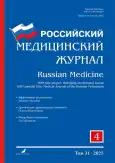Questionnaires for screening relative energy deficiency in sport (RED-S) in women: a systematic review
- Authors: Degteva A.E.1
-
Affiliations:
- North-Western State Medical University named after I.I. Mechnikov
- Issue: Vol 31, No 4 (2025)
- Pages: 384-390
- Section: Reviews
- Submitted: 07.05.2025
- Accepted: 23.06.2025
- Published: 08.09.2025
- URL: https://medjrf.com/0869-2106/article/view/679253
- DOI: https://doi.org/10.17816/medjrf679253
- EDN: https://elibrary.ru/SQYVGS
- ID: 679253
Cite item
Abstract
BACKGROUND: Relative energy deficiency in sport (RED-S) and low energy availability are major issues in modern sports. The constant prevalence of energy expenditure on training and competition over energy intake is the main risk factor for these conditions to occur. Quantifying energy deficiency in everyday practice is rendered difficult, but questionnaires can be an effective tool for timely screening of low energy availability and RED-S.
AIM: To conduct a systematic review of questionnaires used to assess RED-S risk factors in athletes.
METHODS: The presented review was conducted in concert with the methodological guidelines found in the Preferred Reporting Items for Systematic Reviews and Meta-Analyses Extension for Scoping Reviews. A search was conducted through the PubMed, Google Scholar, Embase, Scopus, CINAHL, Medline Ovid, and SPORTDiscus electronic databases from January 2010 to February 2025. The review covered articles setting forth issues regarding the assessment of reproductive health and manifestations of RED-S.
RESULTS: Out of the 29 studies included in the review, ten unique questionnaires were found to identify athletes at risk of energy deficiency. Nine questionnaires were validated, three of which included only screening for eating disorders, without assessing other symptoms or training activity. Two questionnaires were most frequently used in studies and practice: the low energy availability in females questionnaire and the eating disorder examination questionnaire.
CONCLUSION: Questionnaires can be effective in identifying intentional energy restriction, early detection of gynecological pathology, and the risk of energy deficiency in female athletes. Questionnaires are screening tools but not methods for diagnosing RED-S.
Full Text
About the authors
Anastasiia E. Degteva
North-Western State Medical University named after I.I. Mechnikov
Author for correspondence.
Email: a.degteva@fomin-clinic.ru
ORCID iD: 0009-0006-0618-6346
SPIN-code: 6072-4730
MD
Russian Federation, 8 Svetlanovsky ave, Saint Petersburg, 194156References
- Emmonds S, Heyward O, Jones B. The challenge of applying and undertaking research in female sport. Sports Med Open. 2019;5(1):51. doi: 10.1186/s40798-019-0224-x EDN: TKWYTS
- Sim A, Burns SF. Review: questionnaires as measures for low energy availability (LEA) and relative energy deficiency in sport (RED-S) in athletes. J Eat Disord. 2021;9(1):41. doi: 10.1186/s40337-021-00396-7 EDN: GQVITN
- Gallant TL, Ong LF, Wong L, et al. Low energy availability and relative energy deficiency in sport: a systematic review and meta-analysis. Sports Med. 2025;55(2):325–339. doi: 10.1007/s40279-024-02130-0 EDN: KUPZTI
- Ackerman KE, Holtzman B, Cooper KM, et al. Low energy availability surrogates correlate with health and performance consequences of Relative Energy Deficiency in Sport. Br J Sports Med. 2019;53(10):628–633. doi: 10.1136/bjsports-2017-098958
- Moore IS, Crossley KM, Bo K, et al. Female athlete health domains: a supplement to the International Olympic Committee consensus statement on methods for recording and reporting epidemiological data on injury and illness in sport. Br J Sports Med. 2023;57(18):1164–1174. doi: 10.1136/bjsports-2022-106620 EDN: WVMVQX
- Schulz JM, Pohlod L, Myers S, et al. Are female athlete specific health considerations being assessed and addressed in preparticipation examinations? A scoping review and proposed framework. J Sport Health Sci. 2024;14:100981. doi: 10.1016/j.jshs.2024.100981
- Melin A, Tornberg AB, Skouby S, et al. The LEAF questionnaire: a screening tool for the identification of female athletes at risk for the female athlete triad. Br J Sports Med. 2014;48(7):540–545. doi: 10.1136/bjsports-2013-093240
- Martinsen M, Holme I, Pensgaard AM, et al. The development of the brief eating disorder in athletes questionnaire. Med Sci Sports Exerc. 2014;46(8):1666–1675. doi: 10.1249/MSS.0000000000000276
- Fairburn CG, Beglin SJ. Assessment of eating disorders: interview or self-report questionnaire? Int J Eat Disord. 1994;16(4):363–370.
- Gibbs JC, Williams NI, Scheid JL, et al. The association of a high drive for thinness with energy deficiency and severe menstrual disturbances: confirmation in a large population of exercising women. Int J Sport Nutr Exerc Metab. 2011;21(4):280–290. doi: 10.1123/ijsnem.21.4.280
- Cotton MA, Ball C, Robinson P. Four simple questions can help screen for eating disorders. J Gen Intern Med. 2003;18(1):53–56. doi: 10.1046/j.1525-1497.2003.20374.x EDN: BEYOLP
- Tosi M, Maslyanskaya S, Dodson NA, Coupey SM. The female athlete triad: a comparison of knowledge and risk in adolescent and young adult figure skaters, dancers, and runners. J Pediatr Adolesc Gynecol. 2019;32(2):165–169. doi: 10.1016/j.jpag.2018.10.007
- Mountjoy M, Hutchinson M, Cruz L, Lebrun C. Female athlete triad pre participation evaluation. 2008. Available at: https://femaleandmaleathletetriad.org/wp-content/uploads/2019/03/ppe_for_website.pdf
- Foley Davelaar CM, Ostrom M, Schulz J, et al. Validation of an age-appropriate screening tool for female athlete triad and relative energy deficiency in sport in young athletes. Cureus. 2020;12(6):e8579. doi: 10.7759/cureus.8579
- Wagner AJ, Erickson CD, Tierney DK, et al. The diagnostic accuracy of screening tools to detect eating disorders in female athletes. J Sport Rehabil. 2016;25(4):395–398. doi: 10.1123/jsr.2014-0337
- Joy E, De Souza MJ, Nattiv A, et al. 2014 female athlete triad coalition consensus statement on treatment and return to play of the female athlete triad. Curr Sports Med Rep. 2014;13(4):219–232. doi: 10.1249/JSR.0000000000000077 EDN: UTMUHV
- Witkoś J, Błażejewski G, Gierach M. The low energy availability in females questionnaire (LEAF-Q) as a useful tool to identify female triathletes at risk for menstrual disorders related to low energy availability. Nutrients. 2023;15(3):650. doi: 10.3390/nu15030650 EDN: QNVUBZ
- Robertson S, Mountjoy M. A review of prevention, diagnosis, and treatment of relative energy deficiency in sport in artistic (synchronized) swimming. Int J Sport Nutr Exerc Metab. 2018;28(4):375–384. doi: 10.1123/ijsnem.2017-0329
- Loucks AB, Kiens B, Wright HH. Energy availability in athletes. J Sports Sci. 2011;29 Suppl. 1:S7–15. doi: 10.1080/02640414.2011.588958
Supplementary files








